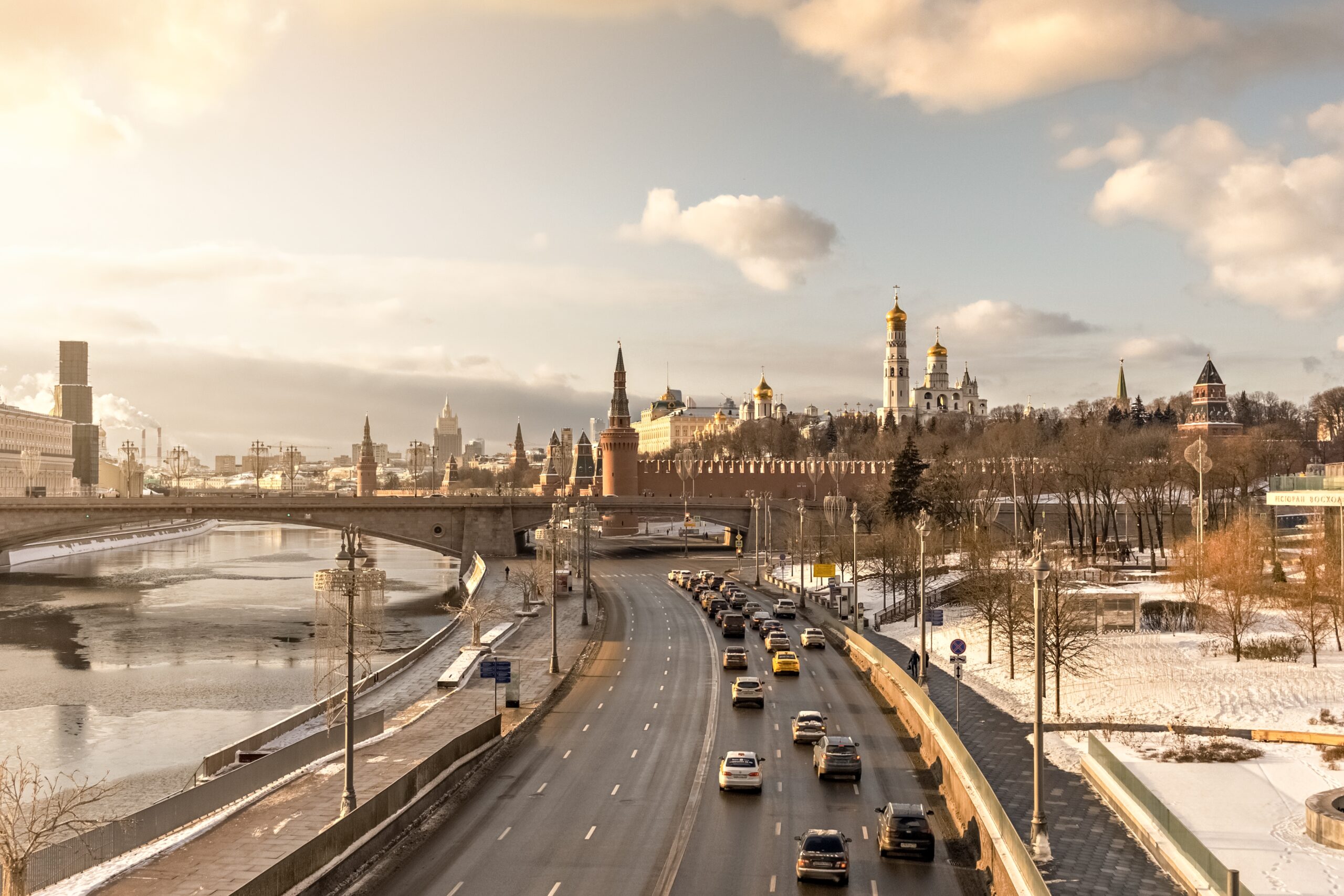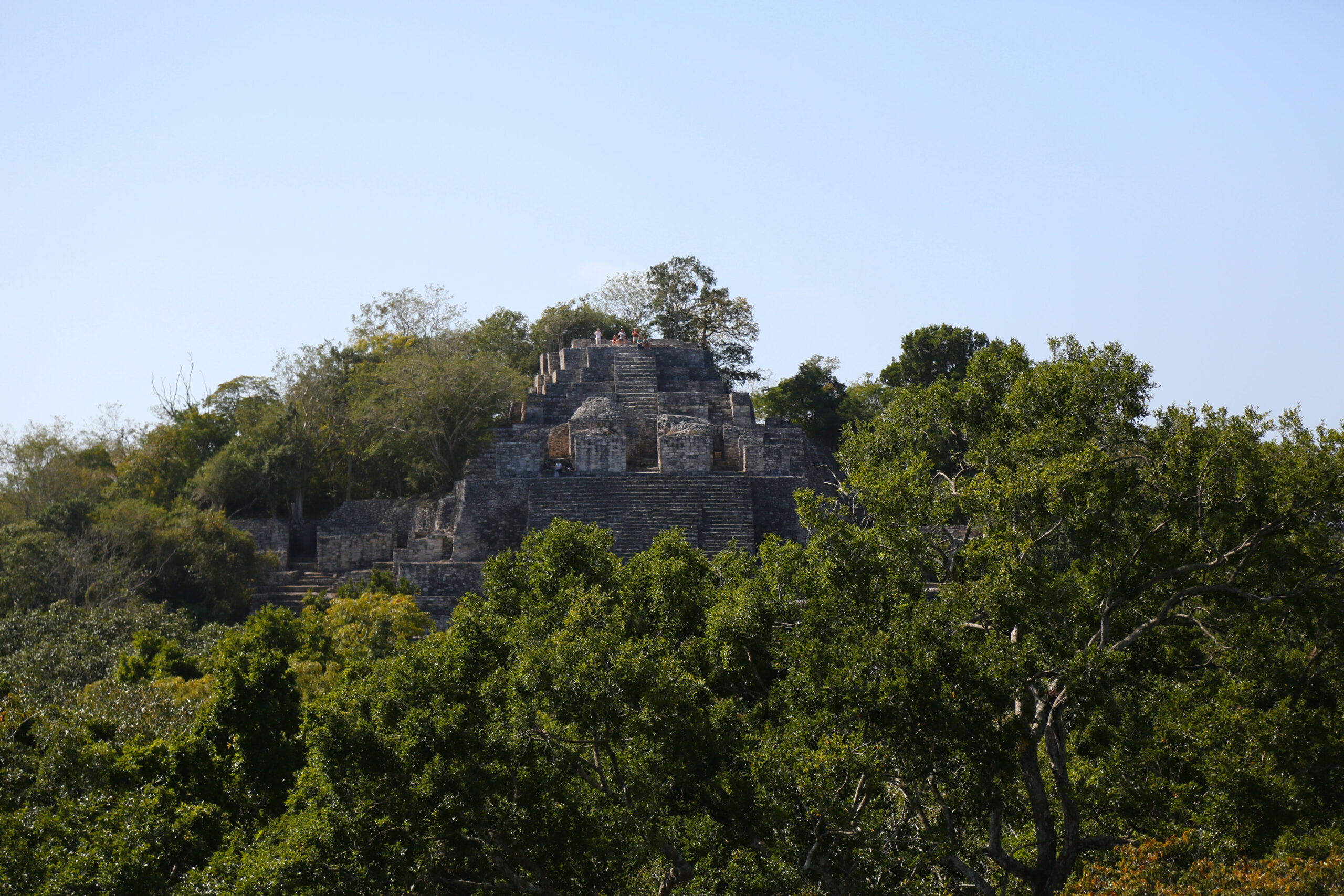The great plains of the northern continents. Lands of hot summers, but cold winters. The bread baskets of the developed world, they are also home to many great cities and are the heartlands for the two largest countries on earth.
In a band encircling the earth of the mid-latitudes… Between the forbidding arctic cold to the north, and the deserts and humid plains to the south… these are the lands of the Continental Climates.
Description and Dynamics
In our journey from equator to pole, we’ll be leaving the southern hemisphere for a time as we set our focus on the great northern continents. Being so far from the moderating influence of the oceans, these continents produce a variety of climate types that have one thing in common – big temperature ranges from summer to winter.
There are two distinct biomes that occur within North America and Eurasia. The colder and more northerly of these is the endless sub-arctic pine forest – known as the Taiga. We’ll take this up in the next chapter. In this one, we’ll look at the warmer of these, which are the mixed woodlands and grasslands that are home to hundreds of millions of people and countless cities stretching across Canada, the United States, Northern and Eastern Europe, Russia and the northern Far East.
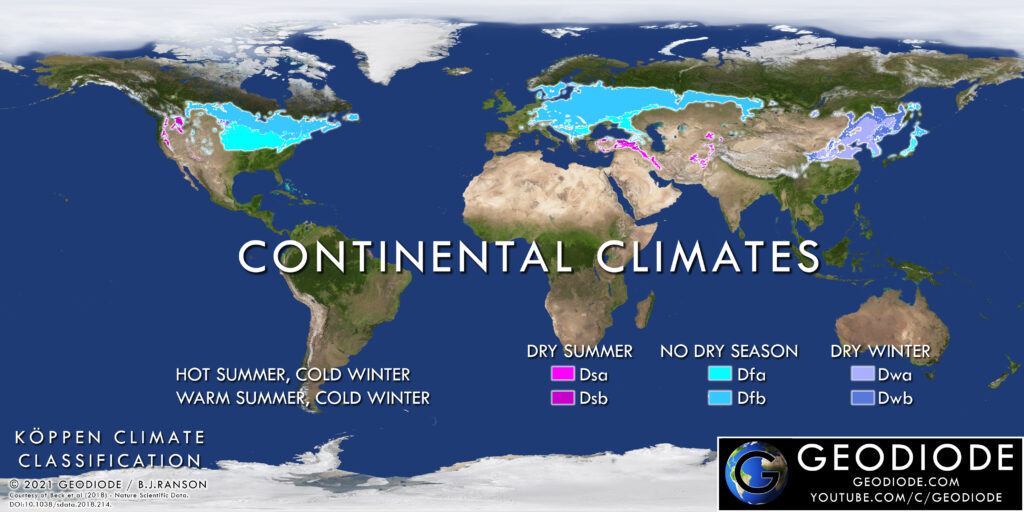
Global distribution of Continental climate zones with the six Koppen codes
In the Koppen Climate Classification, there are, at first a seemingly bewildering number of climates here, six in total. They are subdivided by rainfall pattern and temperature. Where there is a hot summer, with the average day/night temperature being above 22°C, the designation ends in “a”. Where there is a cooler, but still warm, summer below 22°C, the designation ends in “b”.
All continental climates by definition must have the average day/night temperature in winter below -3°C (or 0°C by some climatologists), otherwise they fall under the Oceanic, Mediterranean or Humid Subtropical climates.
Where there are wet winters and dry summers (Koppen: Dsa/Dsb), this is an extension of the Mediterranean climate into adjoining higher altitude areas, and is the least common of the Continental climates, being limited to the interiors of the USA’s Pacific North-West and Turkey, along with the western slopes of the Altai mountains in Central Asia.
When such a rainfall pattern is reversed, with dry winters and wet summers (Koppen: Dwa/Dwb), we have a form of monsoon. In fact the only place where this occurs is in Eastern Asia, where the Asian Monsoon extends far into the north – Eastern Siberia, Northern China and Korea.
The most common continental climate is where the rainfall is distributed relatively evenly throughout the year. Dfa is the continental humid hot summer, while Dfb is the continental humid warm summer variant. These two make up the bulk of the population centres in the mid-latitudes of the Northern Continents and so are especially important.

Continental Dry Summer has Koppen codes Dsa and Dsb, and is relatively rare
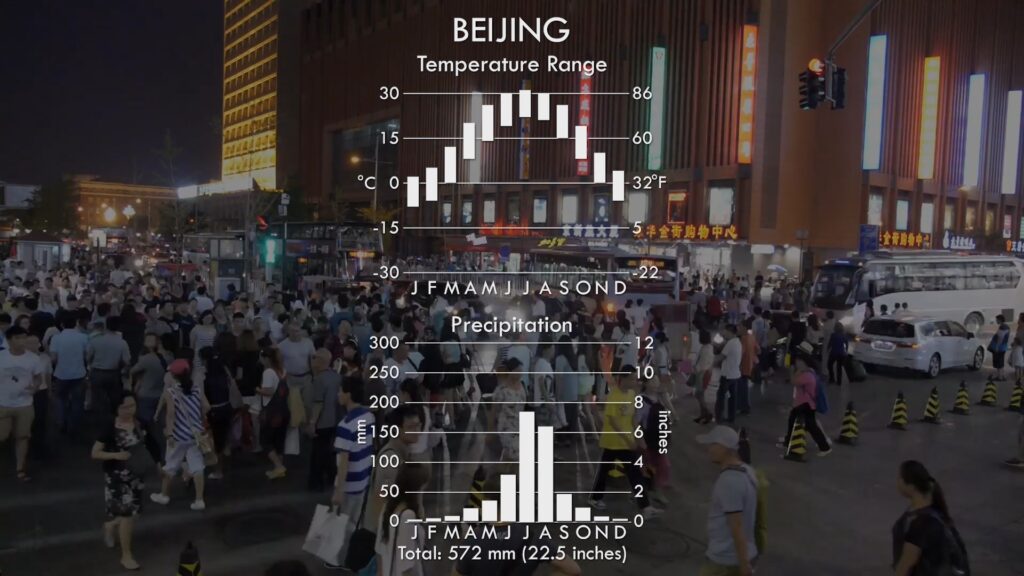
Continental Dry Winter has Koppen codes Dwa and Dwb, and is found only in Eastern Asia due to the Asian Monsoon
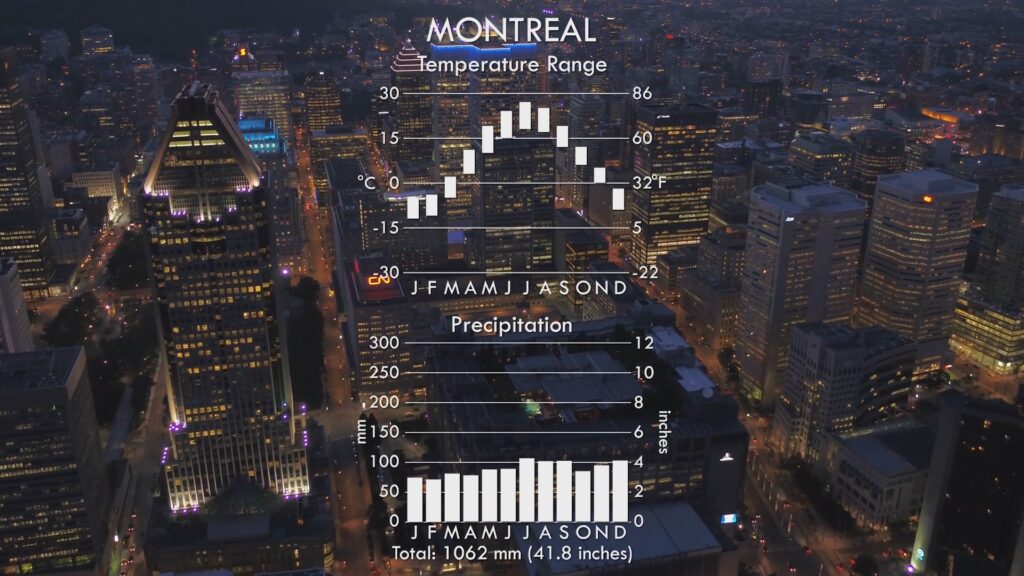
Classic Continental with rain year-round has Koppen codes Dfa and Dfb, and is the most widespread of Continental climates
Now those of you paying attention in the last chapter on Cool Deserts, might recall this concept of “Continentality”, where land is so far from the ocean that it receives little rain. So how is it that these continental interiors can support so much biosphere and population? Well, firstly, they are, on the whole, further north than the cool deserts, which reduces evaporation, due to a weaker sun, and so for a given amount of rain, more plants can grow.
This more northerly latitude also brings much of western and central Eurasia under the sway of wet westerly winds blowing in from the Atlantic, with no mountain ranges to stop them from the Baltic all the way to Siberia. In this way, these areas, mostly of the Dfb warm humid summer variant, can be thought of as a continental form of the Oceanic climate that we looked at in Chapter 7.
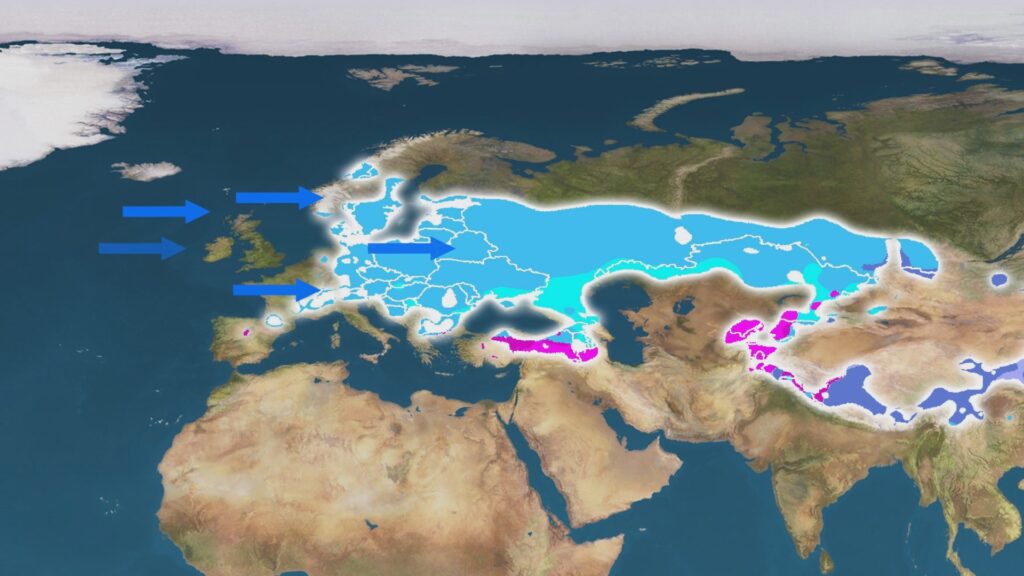
Westerly winds blowing over the flat landscapes of Northern Europe and European Russia bring year-round rain far into Russia in a continental extension of the Oceanic climate
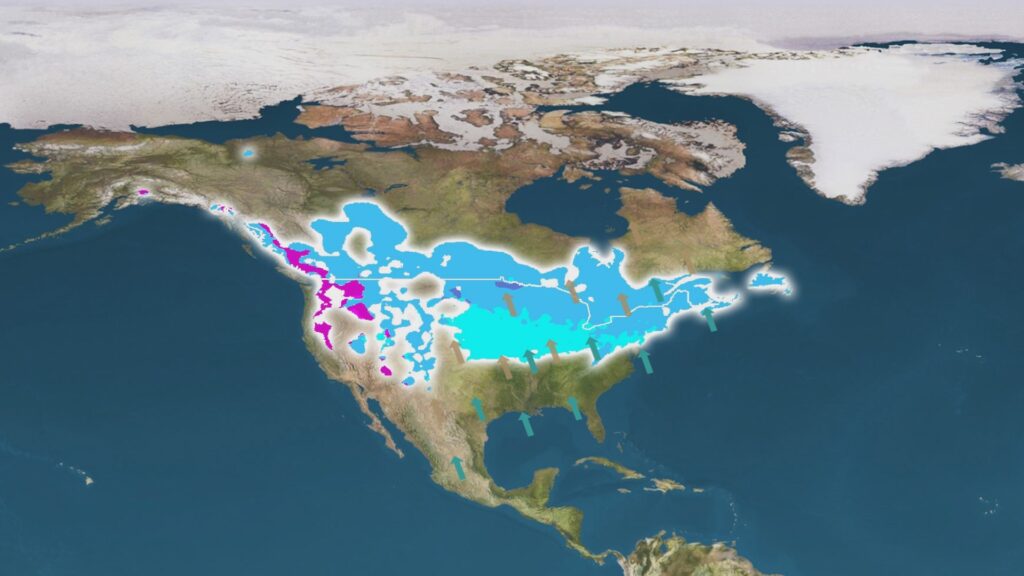
Westerlies in North America are blocked by the rockies so much of the continental climate here can be considered to be an extension of the Humid Subtropical climate
In the case of North America, the moisture from the westerlies is all but blocked by the Rocky Mountains, so much of the rain comes from the humid south. In this respect, this climate can be viewed as simply a colder and drier form of the Humid Subtropical climate that we looked at in Chapter 5. As this warm southern air mixes with the very different colder, drier arctic air over these areas, it often gives rise to extreme weather events in the form of heavy thunderstorms, tornados and hailstorms.
Eastern Asia, like all climates in that region, is subject to the Asian Monsoon, where due to the enormity of this continent and the presence of the Tibetan plateau, the doldrums of tropical wind convergence is p ushed way to the north over Mongolia in summer, producing low pressure that pulls in wet air from the nearby Pacific as far north as Eastern Siberia. In winter, with high pressure over Mongolia, the wind direction is reversed, with dry air now flowing over Northern China, Korea and Eastern Siberia. The result is wet summers and dry winters. Compared to more southerly monsoon areas, though, the total rainfall is much lower. And in general, all the continental climates are relatively dry compared to all but the desert climates
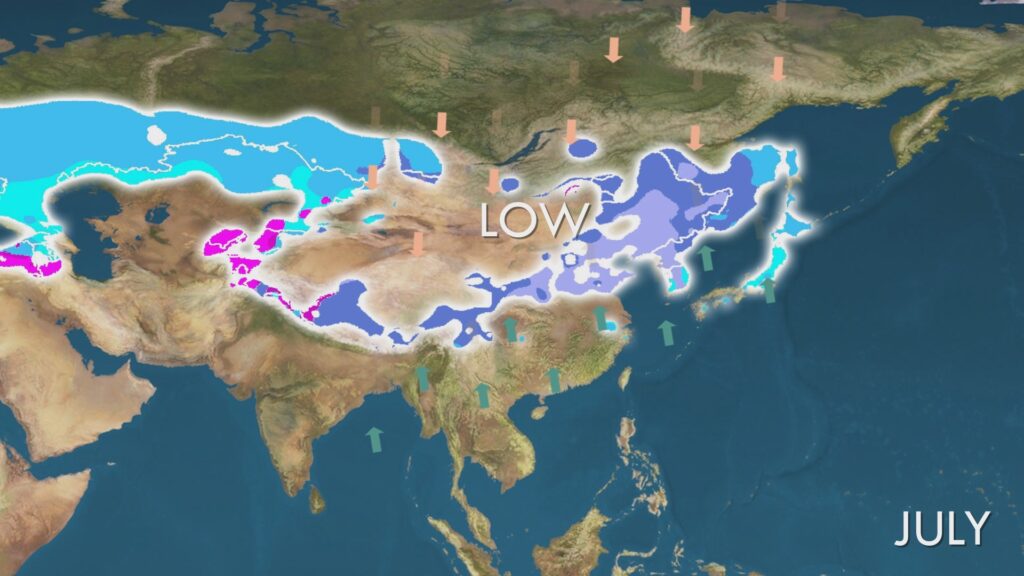
The Eastern Asian Monsoon in summer brings moist Pacific winds onto the continent, and plenty of rain

The Eastern Asian Monsoon in winter is dry since the prevailing wind blows out from Siberia with little moisture
The Continental Climate, with its wide temperature range, has the most distinct of the traditional four season patterns found in the temperate bands. Winters are always cold and snowy, and summers are marked by long days with plenty of warm to hot sun, while Spring and Autumn are found between with their own well known characters.
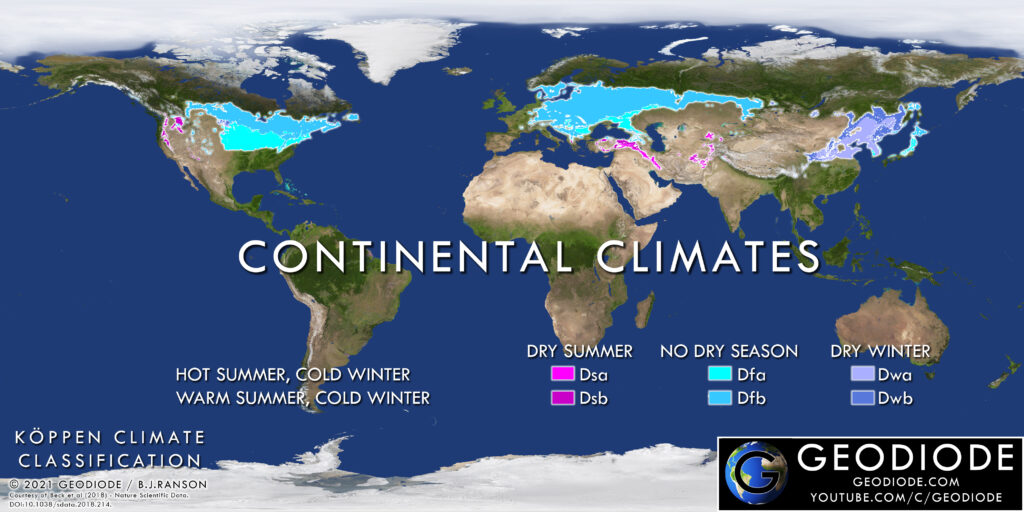
Global distribution of Continental climate zones
Where in the world do we find the Continental climates?
So, where in the world are the continental climate zones? Well, due to the lack of continental land mass below the equator, they all occur in the North.
Beginning just to the east of the Rockies in Canada, the provinces of Alberta and Saskatchewan are dominated by the Cfb warm humid summer variant. Moving east, and this band of Cfb gradually moves south to incorporate the Dakotas, Minnesota, Wisconsin, Michigan, the whole of the Great Lakes region, upper New York state, and all of New England, as well as all the main population centres of Ontario, Quebec and the Maritime Provinces of Canada.
Further south, and the heart of the Mid-West comes under the sway of the hot summer continental Cfa variant, including the states of Nebraska, Kansas, Iowa, Missouri and Illinois. As we head east, this band narrows between the Cfb continental climate to the north and the Humid Subtropical climate to the south, with Indiana, Ohio and Pennsylvania, sheltered from the warm Atlantic by the Appalachian mountains, experiencing cold winters and hot summers.
Skipping across the Atlantic, and past the Oceanic climate zone of North-West Europe, we encounter again a huge area of the Cfb variant of warm summers and cold winters, from Eastern Germany and Southern Scandinavia in the West, moving through all of Eastern Europe, the Baltic States, Ukraine, Belarus and encompassing much of European Russia. This band continues to extend for thousands of miles deep into the heart of Asia and Siberia before finally being squeezed between the sub-arctic forests of the north and the deserts to the south.
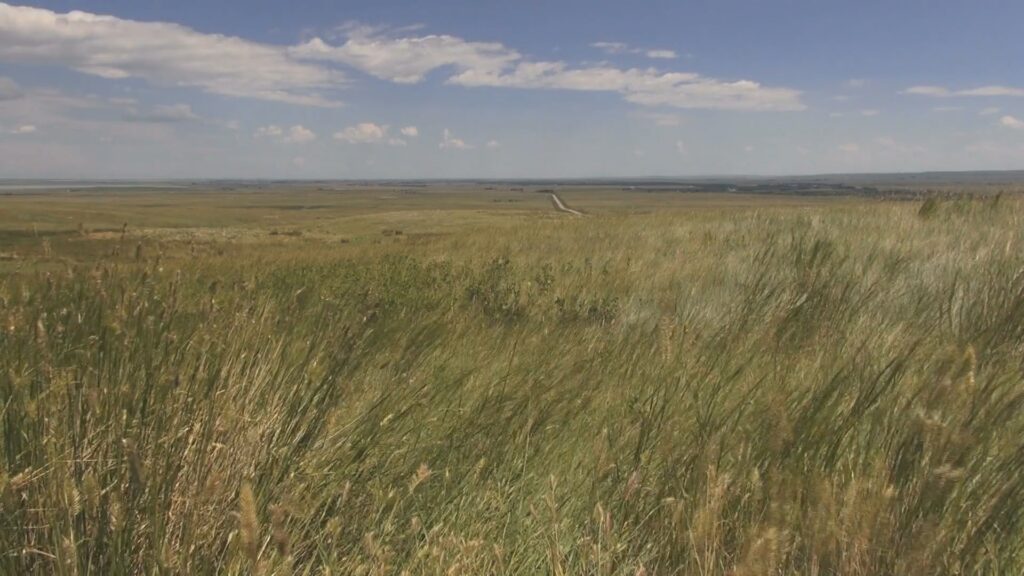
Natural Prairie in Alberta, Canada
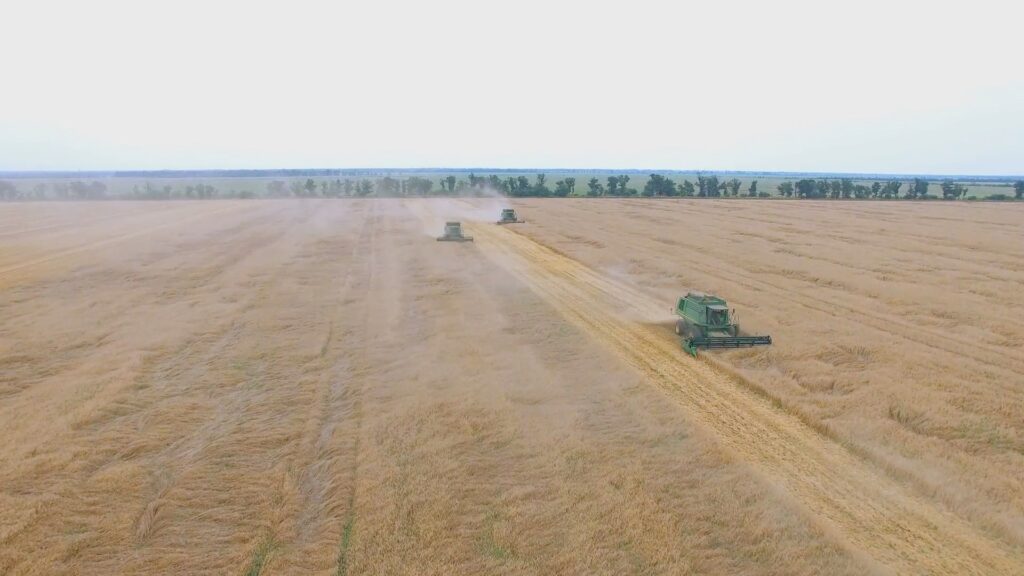
Much of this climate in the USA and Canada is given over to huge farms of wheat and corn

Most of Eastern Europe is in the Continental Climate zone Dfb, include Czechia’s capital Prague
In Eastern Asia, the monsoon Dwa and Dwb variants dominate, with much of northern China and Eastern Siberia and Korea experiencing hot or warm wet summers, and cold dry winters. Due to its extreme altitude, we find the most southerly of all continental climates in Tibet, where much of this plateau experiences cold, dry winters, and a mild to hot wet summer in a similar way.
Lastly, the north of Japan, including the island of Hokkaido, being surrounded by water, has the year round rain of the Dfb variant, while the northern half of Honshu island has the hotter summer Dfa variant. Because of the bitterly cold winter wind blowing off from Siberia over the warm moist Sea of Japan, this results in massive snowfalls over northern Japan – in fact Sapporo, Hokkaido’s capital, is the snowiest city in the world.

Russia’s capital Moscow, lies firmly within the Dfb Continental type

Much of Northern China, including this section of the Great Wall is in the Continental Monsoon climate zone (Dwa, Dwb)
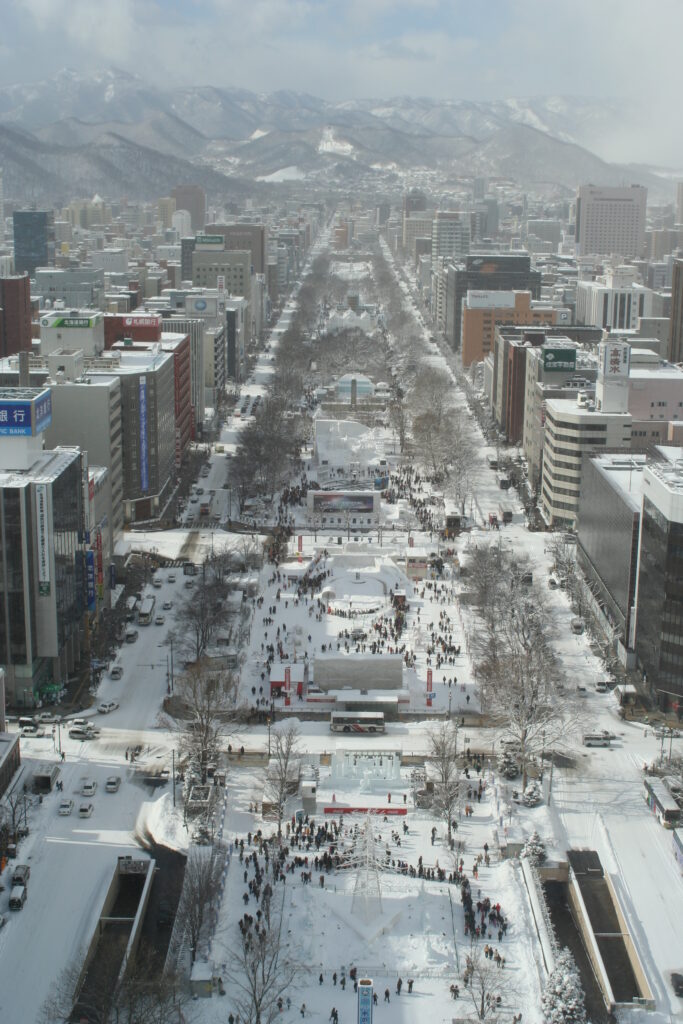
Most of Northern Japan is in the Dfb climate type, with Sapporo being the snowiest major city in the world. Image courtesy of Eckhard Pecher
Landscapes, Vegetation, Agriculture and Cities
The natural vegetation of the continental climate zones is a mixture of grasslands and forests of both deciduous and coniferous varieties, depending on how much rain falls. On the fringes between this and the semi-arid climate, grasslands dominate. On the border with the sub-arctic climates to the North, deciduous woodland gradually gives way to uniform pine forest that we call the taiga.

Notable cities with Continental Climates
Large scale mechanised agriculture dominates these areas. In North America, the endless plains are covered by wheat and corn fields as far as the eye can see. Soybeans and barley are also common. Ukraine and Southern Russia is similarly dominated, while Eastern Europe and Southern Scandinavia, where the climate is milder from bordering on the Oceanic climate, allows for a greater variety of crops and livestock.
Instead of rice which otherwise dominates this country, Northern China sees much of the countryside, like the climatic counterparts in Europe and North America, also given over to wheat, corn and barley production.
Between these endless plains, of course, lie many great and famous cities. Presented in the adjacent graphs are the most notable.
Coursework Questions
- Why are the Continental climates found only in the northern hemisphere?
- Explain the logic behind the six Continental Koppen climate codes, detailing the three rainfall distribution letters and two temperature range letters.
- Summarise the differences between the Continental climates in North America, Europe and Eastern Asia.
- What are the natural biomes and landscapes in these climate zones?
- How important is agriculture in this climate?
- List out some countries, regions and cities that experience Continental climates.
